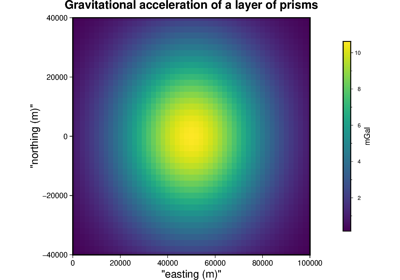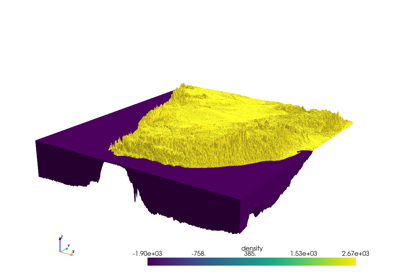harmonica.DatasetAccessorPrismLayer#
- class harmonica.DatasetAccessorPrismLayer(xarray_obj)[source]#
Defines dataset accessor for layer of prisms
Warning
This class is not intended to be initialized. Use the prism_layer accessor for accessing the methods and attributes of this class.
See also
- Attributes:
boundariesBoundaries of the layer
dimsReturn the dims tuple of the prism layer
shapeReturn the number of prisms on each direction
sizeReturn the total number of prisms on the layer
spacingSpacing between center of prisms
Methods
get_prism(indices)Return the boundaries of the chosen prism
gravity(coordinates, field[, progressbar, ...])Computes the gravity generated by the layer of prisms
to_pyvista([drop_null_prisms])Return a pyvista UnstructuredGrid to plot the PrismLayer
update_top_bottom(surface, reference)Update top and bottom boundaries of the layer
- DatasetAccessorPrismLayer.gravity(coordinates, field, progressbar=False, density_name='density', thickness_threshold=None, **kwargs)[source]#
Computes the gravity generated by the layer of prisms
Uses
harmonica.prism_gravityfor computing the gravity field generated by the prisms of the layer. The density of the prisms will be assigned from thedata_varchosen through thedensity_nameargument. Ignores the prisms whichtoporbottomboundaries arenp.nan``s. Prisms thinner than a given threshold can be optionally ignored through the ``thickness_thresholdargument. Allkwargswill be passed toharmonica.prism_gravity.- Parameters:
- coordinates
listofarrays List of arrays containing the
easting,northingandupwardcoordinates of the computation points defined on a Cartesian coordinate system. All coordinates should be in meters.- field
str Gravitational field that wants to be computed. The available fields are: - Gravitational potential:
potential- Eastward acceleration:g_e- Northward acceleration:g_n- Downward acceleration:g_z- Diagonal tensor components:g_ee,g_nn,g_zz- Non-diagonal tensor components:g_en,g_ez,g_nz- progressbarbool (
optional) If True, a progress bar of the computation will be printed to standard error (stderr). Requires
numba_progressto be installed. Default toFalse.- density_name
str(optional) Name of the property layer (or
data_varof thexarray.Dataset) that will be used for the density of each prism in the layer. Default to"density"- thickness_threshold
floatorNone Prisms thinner than this threshold will be ignored in the forward gravity calculation. If None, every prism with non-zero volume will be considered. Default to None.
- coordinates
- Returns:
- result
array Gravitational potential is returned in :math:` ext{J}/ ext{kg}`, acceleration components in mGal, and tensor components in Eotvos.
- result
See also
- DatasetAccessorPrismLayer.to_pyvista(drop_null_prisms=True)[source]#
Return a pyvista UnstructuredGrid to plot the PrismLayer
- Parameters:
- drop_null_prismsbool (
optional) If True, prisms with zero volume or with any
numpy.nanas their top or bottom boundaries won’t be included in thepyvista.UnstructuredGrid. If False, every prism in the layer will be included. Default True.
- drop_null_prismsbool (
- Returns:
- pv_grid
pyvista.UnstructuredGrid pyvista.UnstructuredGridcontaining each prism of the layer as a hexahedron along with their properties.
- pv_grid
- DatasetAccessorPrismLayer.update_top_bottom(surface, reference)[source]#
Update top and bottom boundaries of the layer
Change the values of the
topandbottomcoordinates based on the passedsurfaceandreference. Thetopandbottomboundaries of every prism will be equal to the correspondingsurfaceandreferencevalues, respectively, ifsurfaceis above thereferenceon that point. Otherwise thetopandbottomboundaries of the prism will be equal to its correspondingreferenceandsurface, respectively.- Parameters:
- surface2d-array
Array used to create the uppermost boundary of the prisms layer. All heights should be in meters. On every point where
surfaceis belowreference, thesurfacevalue will be used to set thebottomboundary of that prism, while thereferencevalue will be used to set thetopboundary of the prism.- reference
floator 2d-array Reference surface used to create the lowermost boundary of the prisms layer. It can be either a plane or an irregular surface passed as 2d array. Height(s) must be in meters.

